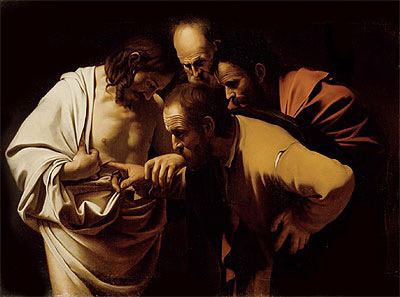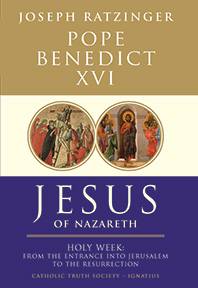April 2012 - Vol. 59.
by
Joseph Ratzinger / Pope Benedict XVI
“If Christ has not been raised, then our preaching is in vain and your faith is in vain. We are even found to be misrepresenting God, because we testified of God that he raised Christ” (1 Corinthians 15:14-15). With these words Saint Paul explains quite drastically what faith in the Resurrection of Jesus Christ means for the Christian message overall: it is its very foundation. The Christian faith stands or falls with the truth of the testimony that Christ is risen from the dead. If this were taken away, it would still be possible to piece together from the Christian tradition a series of interesting ideas about God and men, about man’s being and his obligations, a kind of religious world view: but the Christian faith itself would be dead. Jesus would be a failed religious leader, who despite his failure remains great and can cause us to reflect. But he would then remain purely human, and his authority would extend only so far as his message is of interest to us. He would no longer be a criterion; the only criterion left would be our own judgment in selecting from his heritage what strikes us as helpful. In other words, we would be alone. Our own judgment would be the highest instance. Only if Jesus is risen has anything really new occurred that changes the world and the situation of mankind. Then he becomes the criterion on which we can rely. For then God has truly revealed himself. To this extent, in our quest for the figure of Jesus, the Resurrection is the crucial point. Whether Jesus merely was or whether he also is – this depends on the Resurrection. In answering yes or no to this question, we are taking a stand not simply on one event among others, but on the figure of Jesus as such. Therefore it is necessary to listen with particular attention as the New Testament bears witness to the Resurrection. Yet first we have to acknowledge that this testimony, considered from a historical point of view, is presented to us in a particularly complex form and gives rise to many questions. Witnesses
who
encountered the risen Lord
Anyone approaching the Resurrection accounts in the belief that he knows what rising from the dead means will inevitably misunderstand those accounts and will then dismiss them as meaningless. Rudolf Bultmann raised an objection against Resurrection faith by arguing that even if Jesus had come back from the grave, we would have to say that “a miraculous natural event such as the resuscitation of a dead man” would not help us and would be existentially irrelevant (cf. New Testament and Mythology, p. 7). Now it must be acknowledged that if in Jesus’ Resurrection we were dealing simply with the miracle of a resuscitated corpse, it would ultimately be of no concern to us. For it would be no more important than the resuscitation of a clinically dead person through the art of doctors. For the world as such and for our human existence, nothing would have changed. The miracle of a resuscitated corpse would indicate that Jesus’ Resurrection was equivalent to the raising of the son of the widow of Nain (Luke 7:11-17), the daughter of Jairus (Mark 5:22-24, 35-43 and parallel passages), and Lazarus (John 11:1-44). After a more or less short period, these individuals returned to their former lives, and then at a later point they died definitively. The New Testament testimonies leave us in no doubt that what happened in the “Resurrection of the Son of Man” was utterly different. Jesus’ Resurrection was about breaking out into an entirely new form of life, into a life that is no longer subject to the law of dying and becoming, but lies beyond it – a life that opens up a new dimension of human existence. Therefore the Resurrection of Jesus is not an isolated event that we could set aside as something limited to the past, but it constitutes an “evolutionary leap” (to draw an analogy, albeit one that is easily misunderstood). In Jesus’ Resurrection a new possibility of human existence is attained that affects everyone and that opens up a future, a new kind of future, for mankind. Inseparable
link
with Jesus' Resurrection and ours
On this basis we can understand the unique character of this New Testament testimony. Jesus has not returned to a normal human life in this world like Lazarus and the others whom Jesus raised from the dead. He has entered upon a different life, a new life – he has entered the vast breadth of God himself, and it is from there that he reveals himself to his followers. For the disciples, too, this was something utterly unexpected, to which they were only slowly able to adjust. Jewish faith did indeed know of a resurrection of the dead at the end of time. New life was linked to the inbreaking of a new world and thus made complete sense. If there is a new world, then there is also a new mode of life there. But a resurrection into definitive otherness in the midst of the continuing old world was not foreseen and therefore at first made no sense. So the promise of resurrection remained initially unintelligible to the disciples. The process of coming to Resurrection faith is analogous to what we saw in the case of the Cross. Nobody had thought of a crucified Messiah. Now the “fact” was there, and it was necessary, on the basis of that fact, to take a fresh look at Scripture. We saw in the previous chapter how Scripture yielded new insights in the light of the unexpected turn of events and how the “fact” then began to make sense. Admittedly, the new reading of Scripture could begin only after the Resurrection, because it was only through the Resurrection that Jesus was accredited as the one sent by God. Now people had to search Scripture for both Cross and Resurrection, so as to understand them in a new way and thereby come to believe in Jesus as the Son of God. This also presupposes that for the disciples the Resurrection was just as real as the Cross. It presupposes that they were simply overwhelmed by the reality, that, after their initial hesitation and astonishment, they could no longer ignore that reality. It is truly he. He is alive; he has spoken to us; he has allowed us to touch him, even if he no longer belongs to the realm of the tangible in the normal way. Living
anew forever
in the power of God
But could it really be true? Can we – as men of the modern world – put our faith in such testimony? “Enlightened” thinking would say no. For Gerd Lüdemann, for example, it seems clear that in consequence of the “revolution in the scientific image of the world . . . the traditional concepts of Jesus’ Resurrection are to be considered outdated” (quoted in Wilckens, Theologie des Neun Testaments 1/2, pp. 119-20). But what exactly is this “scientific image of the world”? How far can it be considered normative? Hartmut Gese in his important article “Die Frage des Weltbildes”, to which I should like to draw attention, has painstakingly described the limits of this normativity. Naturally there can be no contradiction of clear scientific data. The Resurrection accounts certainly speak of something outside our world of experience. They speak of something new, something unprecedented – a new dimension of reality that is revealed. What already exists is not called into question. Rather we are told that there is a further dimension, beyond what was previously known. Does that contradict science? Can there really only ever be what there has always been? Can there not be something unexpected, something unimaginable, something new? If there really is a God, is he not able to create a new dimension of human existence, a new dimension of reality altogether? Is not creation actually waiting for this last and highest “evolutionary leap”, for the union of the finite with the infinite, for the union of man and God, for the conquest of death? Jesus'
Resurrection
– smallest mustard of history
This reversal of proportions is one of God’s mysteries. The great – the mighty – is ultimately the small. And the tiny mustard seed is something truly great. So it is that the Resurrection has entered the world only through certain mysterious appearances to the chosen few. And yet it was truly the new beginning for which the world was silently waiting. And for the few witnesses – precisely because they themselves could not fathom it – it was such an overwhelmingly real happening, confronting them so powerfully, that every doubt was dispelled, and they stepped forth before the world with an utterly new fearlessness in order to bear witness: Christ is truly risen. [Excerpt
from Jesus
of
Nazareth: Holy Week: From the Entrance Into
Jerusalem To The Resurrection,
by Joseph Ratzinger/Pope Benedict XVI, Chapter 9, ©
2011 Ignatius
Press, San Francisco. Used with permission.]
|
. | |||
|
|
. |

